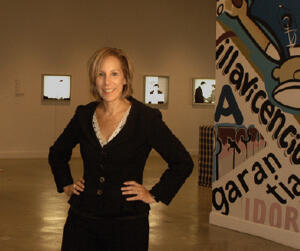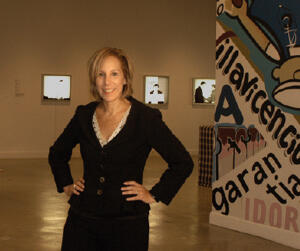PROFILE: Bonnie Clearwater: A Catalyst in the Relationship between Art and Life in Miami
The name of Bonnie Clearwater, director of the Museum of Contemporary Art in North Miami, is associated to the vertiginous transformation of the Miami art scene. She has not only been a visionary in terms of understanding the artistic potentials of creators such as Daniel Arsham, who was only twenty years old when he presented his first exhibition at MOCA, but she has also contributed to model the conception of art and its network of relationships in a city that is reinventing itself as a cultural vortex.

Clearwater is an instigator of the way in which art is created, exhibited, and socially assimilated in Miami. Her role is also central to the connection with contemporary creation at the global level. But above all, she is one of the minds capable of maintaining a permanently open passage between art and the life of the community.
This role is certainly related to the mission of a museum created to “provide a forum for young and emerging local artists and allow them to share the exhibition space with renowned creators”. But what she has done – guided by the irreplaceable passion characteristic of visionary people – is, above all, to transcend the institutional framework and render art an experience capable of transforming people’s lives. Not only of artists, collectors, or people related to the art world, but also of sectors that have no access to it.
If on the one hand, her role in transforming MOCA into a catalyst factor as its director has been duly recognized –for instance, through the five million dollar contribution granted by the Knight Foundation to endow the exhibition program of emerging artists – on the other hand, her concern with educational workshops including those who have never before set foot in a museum has been clearly evident. The museum’s social projection has even had an incidence on the development of urban projects. There is an interconnection between the city of North Miami and MOCA, and she is extremely enthusiastic about the building projects in the neighborhood where the museum is located, since the reasonable prices will permit the creation of a community of artists partaking in the life and work of the area. She considers the concept “of a big density of artists living and working in Miami” essential.
For Clearwater, this informal atmosphere of everyday exchanges, exhibitions organized by the artists themselves, and disturbing spontaneous conversations is an irreplaceable niche for the new generations of artists. Perhaps this is due to the family dialogues on psychology, creativity, or the world around them that she and her brothers used to engage in, under the guidance of their father, a composer. This was a fertile exchange that allowed her to interview, at age 16, the realist socialist painter Isaac Soyer. She was only 19 when Robert Littman, director of the famous Grey Art Gallery at New York University, bet on her visual keenness. He became an archetype for her: he taught her to go beyond her own cultural coordinates and recognize the importance of an exhibitions program that might reflect the changing nature of art. She participated as curator in exhibitions of work by such figures as Lee Krasner, or Rothko (Tate Gallery has just published her insightful book – Mark Rothko – based on the mentioned artist) and in fundraising endeavors to support valuable under-recognized artists who currently boast lengthy careers. Twenty years ago, she recommended Carmen Herrera. In 1985, she was appointed Executive Director of the Lannan Foundation Art Programs in Los Angeles. There she developed experimental art programs. At the Peter Norton Foundation, in Santa Monica, she approached Mexican and African-American artists. Since 1996, when MOCA was inaugurated, she has not only made the visits of artists such as Yoko Ono, Robert Rauschenberg, Larry Rivers, Roy Lichtenstein or John Baldessari possible, but she has also become a catalyst force for a long list of artists who have had their first museum exhibitions at MOCA, and who are currently incorporated in the demanding network of the world market – Daniel Arsham, Hernán Bas, William Córdova, Teresita Fernández, and Mark Handforth to mention just a few.
In 1996, she curated Defining the Nineties: Consensus Making in New York, Miami and Los Angeles, after having lived in each of these cities; it featured an impeccable selection of local artists of that time, such as Robert Chambers, José Bedia, or Rubén Torres Llorca, alongside works by key Latin American artists such as Félix González-Torres, José Antonio Hernández-Diez, Gabriel Orozco, Ernesto Nieto, Quisqueya Hernández and artists from the United States and Europe, such as Matthew Barney, Damien Hirst, or Jac Leirner. Among the 29 residents in the city who participated in MOCA&Miami, in 2006 – in recognition of the museum having offered them, for instance, a space in which to create their installations, which they could never have developed in their studios – mention may be made of Hernan Bas, Naomi Fisher, Gean Moreno, Tao Rey, John Espinosa, Jorge Pantoja, Bhakti Baxter, Pablo Cano, and Natalia Benedetti. They all had an artistic itinerary consistent with their attempt to narrate a story of their own at the museum, which offers a house for local artists and a window to the world.
In any case, Clearwater regrets the fact that, while Miami was a vibrant community of artists (invigorated to a great extent by the key 80s generation of Cuban artists) living in neighborhoods around the downtown in the mid-1990s, “the intervention of real estate developers building new condos, consequently pushed up property prices to such an extent that this community dispersed. Many went to live in other cities, and in any case, the daily interaction that allowed them to improvise artistic events based on their daily encounters was cut short”. Undoubtedly, she feels certain longing for the atmosphere of those days, which, also thanks to artists such as Mark Handforth and Dara Friedman, who lived in the city, produced a dialogue oriented towards “conceptual art” in such a way that there was a sort of continuity of thought in these artists’ life and art. When Clearwater hired Ruba Katrib as Assistant Curator at MOCA, she considered it essential that Katrib should go out of the museum and get together informally with local artists and people in general for lunch, or to talk about their ideas, and remain receptive to what was going on in the art world. “To be as inclusive as possible” is a life principle for Bonnie, perhaps derived from her studies of Medieval Art at Columbia University. In medieval times, art was interconnected with all aspects of life.
A program whose title, “5 minutes of fame”, was inspired by Warhol’s legendary expression, “15 Minutes of Fame”, gives young local artists an opportunity to present their art projects in an open public forum, in groups of up to ten participants each night. “We motivate the public, the new collectors, the critics, so that they come and see the work of these artists: we do not know who will be there”. Numerous initiatives – programs and exhibitions – featured by MOCA offset the absence of an artistic density such as the one that existed in Miami a decade ago. And, of course, they take advantage of the paroxysm of the enthusiasm for art aroused by Art Basel Miami Beach. The concept of a personal, instigating gaze, in close association with her efforts to stress the importance of ‘density’ in a creative community have marked Clearwater’s career.
PERFIL: Bonnie Clearwater is currently Director and Chief Curator of the Museum of Contemporary Art (MoCA Miami). She is also the former Executive Director of Lannan Foundation Art Program in Los Angeles, and Director of the Lannan Museum in Lake Worth, Florida. She was the curator of The Mark Rothko Foundation in New York and served as an advisor to the 2002 Whitney Biennial, was a juror for the Lucilla Award, National Museum of Art, Smithsonian Institution, Washington D.C.; and Advisor for the Altoids Collection, 2002. She has written extensively on Contemporary and Modern art.”
-
 Photo: Betty Rosado
Photo: Betty Rosado


